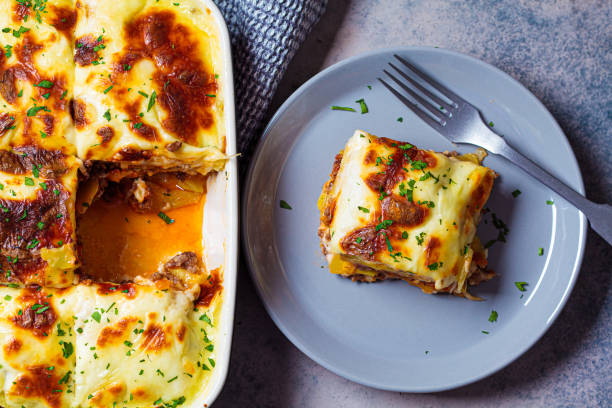
Introduction to Moussaka
Moussaka isn’t just another dish it’s a story baked into layers. Imagine thin slices of eggplants soaked in olive oil, a rich tomato and meat sauce simmering with fragrant spices, and a creamy béchamel that blankets everything in a golden, velvety finish. This classic Greek comfort food is more than just a mealit’s a warm hug straight from the Mediterranean. Moussaka perfectly captures the soul of Greek cooking: simple ingredients, cooked slowly, layered beautifully, and bursting with love. It’s a dish that graces family tables, Sunday gatherings, and festive occasions across Greece and beyond. Whether you’re making it for a celebration or just to treat yourself, once you’ve tasted real homemade moussaka, you’ll never forget it. Let’s dive into its roots, layers, ingredients, and secrets to creating the perfect traditional Greek moussaka from scratch.
What is Moussaka?
At its core, moussaka is a layered casserole that combines roasted eggplants, a rich and flavorful ground meat sauce, and a creamy béchamel topping. It’s baked until golden and slightly crisp on top, revealing a perfectly balanced dish with deep, savory, and subtly sweet flavors. Think of it as the Greek cousin to Italian lasagna but instead of pasta sheets, you’ll find layers of eggplants; instead of cheese, you’ll find silky béchamel infused with nutmeg. It’s hearty yet elegant, indulgent yet wholesome. When served, each slice stands tall, showing off its beautiful layers like edible architecture. The top is lightly golden and firm, the middle is juicy and aromatic, and the base is tender with a touch of smokiness from the eggplants. Every bite tells you why moussaka is one of Greece’s most beloved dishes.
The Origins of Moussaka
Moussaka’s history is a fascinating blend of cultures. Although today it’s synonymous with Greece, the dish actually traces its origins back to the Middle East. The word “moussaka” comes from the Arabic “musakhkhan,” which means “something that is heated.” The modern Greek version was perfected in the early 20th century by Chef Nikolaos Tselementes, who introduced the French-inspired béchamel sauce. Before his version, traditional moussaka consisted mainly of eggplants and minced meat simple but bold. The béchamel topping elevated it to a sophisticated dish worthy of any celebration. Today, moussaka remains a symbol of Greek culinary pride, but its variations are found throughout the Balkans, Turkey, and the Middle East each with unique twists that reflect local tastes and ingredients.
Why Moussaka is Loved Worldwide
So, what makes moussaka a global favorite? Its universal appeal lies in its layers of comfort, aroma, and flavor. It’s rich but not heavy, complex yet easy to make. The warm spices cinnamon, oregano, and nutmeg—blend harmoniously with the tomato sauce and roasted eggplants, creating an aroma that instantly makes you hungry. It’s also incredibly versatile. You can use lamb for a more traditional flavor, beef for a milder taste, or even lentils for a vegetarian twist. It freezes beautifully, reheats well, and often tastes better the next day when the flavors meld together. Whether enjoyed in a small taverna overlooking the Aegean Sea or at home on a chilly evening, moussaka always feels special a reminder that food can be both comforting and artful.
Essential Ingredients for Authentic Greek Moussaka
Let’s break down what you’ll need to make this mouthwatering dish. Quality ingredients are key—each element adds its own layer of flavor and texture.
Ingredients:
For the Base:
- 2 large eggplants, sliced lengthwise into ¼ inch-thick slices
- Salt (to remove bitterness)
- Extra virgin olive oil (for brushing and frying)
- 4 tablespoons breadcrumbs
For the Meat Sauce:
- 1 large yellow onion, finely chopped
- 1 pound ground lamb or beef
- 1 tablespoon dried oregano
- 1 teaspoon ground cinnamon
- ½ teaspoon black pepper
- ½ teaspoon ground nutmeg
- ½ teaspoon paprika or hot paprika
- ½ cup unsweetened grape juice
- 1 (14-ounce) can diced tomatoes
- 1 teaspoon sugar
- ½ cup hot beef broth
For the Béchamel Sauce:
- ⅓ cup + 2 tablespoons extra virgin olive oil
- ⅔ cup all-purpose flour
- ½ teaspoon salt (or more, to taste)
- ¼ teaspoon ground nutmeg
- 4 cups 2% milk, warmed
- 2 large eggs
Each ingredient plays a vital role in creating balance. The spices add warmth, the grape juice adds depth, and the béchamel adds luxury. When combined, they create a dish that’s perfectly layered and deeply satisfying.
Step-by-Step Guide: How to Make Traditional Greek Moussaka
1. Preparing the Eggplants
Eggplants are the backbone of moussaka. Slice them lengthwise into ¼-inch thick pieces and sprinkle with salt. Let them sit for 20–30 minutes to draw out excess moisture and reduce bitterness. Pat dry with paper towels. Brush each slice lightly with olive oil and roast them on a baking sheet at 400°F (200°C) for 20–25 minutes until golden and tender. Roasting (instead of frying) keeps them light and prevents the dish from becoming greasy. Once done, set aside to cool slightly.
2. Making the Savory Meat Sauce
In a large skillet, heat a drizzle of olive oil over medium heat. Add finely chopped onions and sauté until translucent. Add your ground lamb or beef and cook until browned. Season with oregano, cinnamon, nutmeg, black pepper, and paprika. Stir in the unsweetened grape juice and let it simmer until slightly reduced, enriching the flavor. Next, add diced tomatoes, sugar, and beef broth. Simmer uncovered for about 20–25 minutes until the sauce thickens and the flavors meld. The result? A fragrant, slightly sweet, and savory sauce that’s pure comfort.
3. Crafting the Creamy Béchamel Sauce
In a medium saucepan, heat olive oil over medium-low heat. Whisk in flour to form a smooth paste (roux). Gradually add the warmed milk while whisking continuously until the mixture thickens and becomes velvety. Season with salt and nutmeg, then remove from heat and let it cool slightly. Beat the eggs in a separate bowl, then slowly whisk them into the sauce. This gives the béchamel its signature richness and creamy consistency. Bechamel sauce mad for this recipe is a bit more thick because of eggs and also added richness to the dish.
4. Assembling and Baking the Moussaka
Now comes the fun part layering! you can adjust it as per your choice. Sprinkle breadcrumbs evenly across the bottom of a baking dish. Arrange half of the roasted eggplants neatly, then spread the entire meat sauce over the eggplants. Add the remaining eggplant slices and pour the creamy béchamel sauce evenly over the top, smoothing it with a spatula now add any type of cheese on its top for more enhancing looks. Bake at 350°F (175°C) for 45–50 minutes until the top is golden brown and bubbling. Allow it to rest for at least 30 minutes before serving it helps the layers set beautifully. When you finally cut into it, the layers should hold their shape perfectly, revealing the magic inside.
Pro Tips for Perfect Moussaka
- Salt and roast the eggplants before layering to avoid sogginess.
- Use lamb for authentic Greek flavor, or beef for a lighter version.
- Whisk the béchamel slowly to prevent lumps and achieve a silky texture.
- Let the moussaka cool before slicing it makes cleaner portions.
- Always use good-quality extra virgin olive oil for the best flavor.
Nutritional Information of Moussaka
| Nutrient | Amount (per serving) |
|---|---|
| Calories | ~430 kcal |
| Protein | 22g |
| Carbohydrates | 24g |
| Fat | 28g |
| Fiber | 5g |
| Calcium | 120mg |
| Iron | 3mg |
Moussaka is a wholesome and balanced dish packed with protein, fiber, and healthy fats. The olive oil contributes heart-healthy monounsaturated fats, while the eggplants add antioxidants and fiber.
Moussaka Variations from Around the World
Every region adds its twist to moussaka. Turkish Moussaka uses sautéed eggplants layered with meat and tomatoes but skips the béchamel. Middle Eastern Moussaka is often vegetarian, made with eggplants, chickpeas, and tomatoes, served cold as a stew. Balkan Moussaka uses potatoes instead of eggplants for a heartier version. For modern diets, try Vegan Moussaka with lentils and plant-based milk for a creamy yet dairy-free option.
How to Serve Moussaka
Moussaka is satisfying on its own, but it shines even more when paired thoughtfully. Serve it with a Greek salad made of tomatoes, cucumbers, olives, and feta for freshness. Add some crusty bread to soak up the sauce. For drinks, pair it with grape juice spritzers or Greek red wines like Xinomavro to complement its rich flavors.
Storing and Reheating Moussaka
Moussaka stores beautifully. Keep leftovers covered in the refrigerator for up to 4 days. To freeze, wrap individual portions in foil and freeze for up to 2 months. When ready to eat, reheat in the oven at 350°F for 20 minutes. Avoid microwaving to maintain texture and flavor.
Common Mistakes to Avoid
- Skipping the salting step for eggplants.
- Using too much oil while roasting.
- Not thickening the béchamel properly.
- Cutting before it sets.
Patience is key each step builds toward perfection.
Why Homemade Moussaka Beats Restaurant Versions
Homemade moussaka wins every time. It’s fresher, healthier, and made with love. You can customize it add more spices, reduce oil, or make it vegetarian. The process itself is rewarding, filling your home with the cozy aroma of Greek kitchens. Plus, it tastes even better the next day as the flavors meld and deepen.
Frequently Asked Questions About Moussaka
1. Can I make moussaka ahead of time? Yes! Assemble it a day ahead, refrigerate, and bake the next day.
2. What’s the best meat for moussaka? Lamb offers the most authentic Greek taste, but beef works beautifully too.
3. Can I use potatoes instead of eggplants? Absolutely, for a denser texture.
4. How do I make gluten-free moussaka? Replace flour in the béchamel with gluten-free flour or cornstarch.
5. Is moussaka better the next day? Yes resting enhances the flavour and makes cutting easier. But it better to microwave it don’t bake this will destroy the top layers flavours more.
Conclusion
Moussaka is the heart of Greek cuisine a beautiful blend of layers, textures, and flavors. From tender roasted eggplants to the flavorful meat sauce and silky béchamel, every element comes together in harmony. It’s a dish that celebrates tradition, family, and the joy of home cooking. Whether you’re recreating it for a holiday feast or a cozy dinner, homemade moussaka will always leave a lasting impression. Try this recipe once, and it’s sure to become a family favorite.
Please don’t forget to leave a review.
